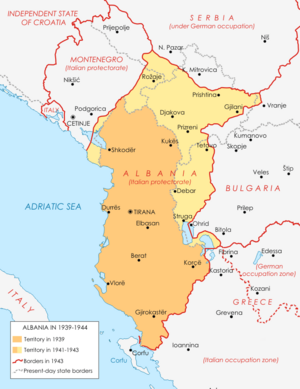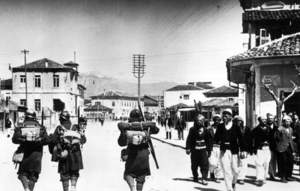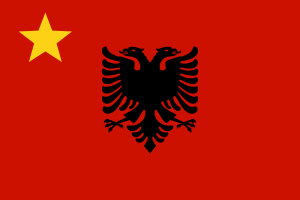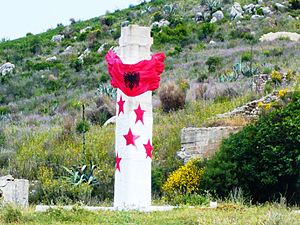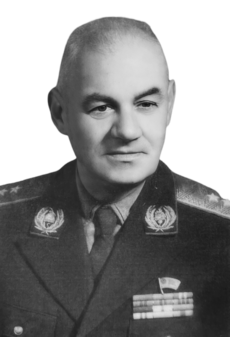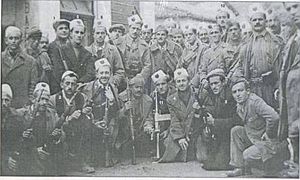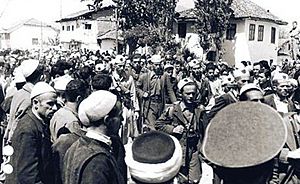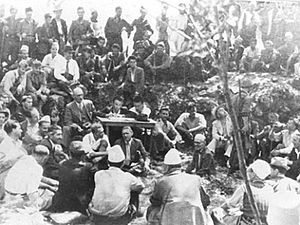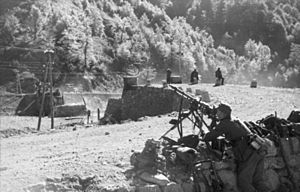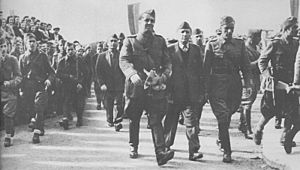World War II in Albania facts for kids
Quick facts for kids World War II in Albania |
||||||||
|---|---|---|---|---|---|---|---|---|
| Part of the European theatre and Mediterranean and Middle East theatre of World War II | ||||||||
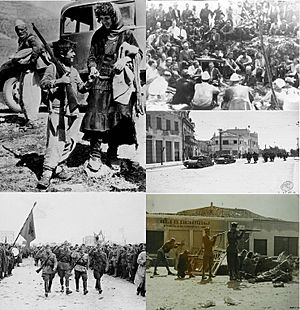 Clockwise from top left: Albanian refugees crossing the border to Yugoslavia in April 12, 1939, Ballists and Communists converse during Mukje Agreement 1943, Italian troops in Durrës, Communist Partisans fighting in Tirana 1944, Partisans march through Tirana after occupying it 28 November 1944 |
||||||||
|
||||||||
| Belligerents | ||||||||
|
(until 1943) |
|
|
||||||
| Commanders and leaders | ||||||||
|
|
|||||||
| Strength | ||||||||
| 1942 ~4,000 1944 ~40,000 |
More than 700,000 Axis troops were stationed | |||||||
| Casualties and losses | ||||||||
| Around (including civilians) 28,000 killed 12,600 wounded 44,500 imprisoned or deported. |
Axis and collaborators: 26,595 killed 21,245 wounded 20,800 prisoners. |
|||||||
World War II started in Albania when Italy invaded the country in April 1939. Fascist Italy took control of Albania, making it a "protectorate" or "puppet state." This meant Italy controlled Albania's government and military.
Most of the resistance against the Italian and later German occupation came from groups who believed in Communism. At first, these groups worked separately. But in early 1942, they joined forces. This led to Albania being successfully freed in 1944.
After the war, Albania was one of the most damaged countries in Europe. About 60,000 homes were destroyed. Around 10% of the people lost their homes.
Contents
Why Did Italy Invade Albania?
In early 1939, Benito Mussolini, Italy's leader, decided to take over Albania. This happened after Germany had taken over Austria and parts of Czechoslovakia without telling Mussolini. Italy's King Victor Emmanuel III thought invading Albania was too risky.
However, on March 25, 1939, Italy gave Albania an ultimatum. They demanded to occupy Albania. King Zog of Albania refused to accept money in exchange for Italy taking over his country. So, on April 7, 1939, Mussolini's troops, led by General Alfredo Guzzoni, invaded Albania. They attacked all Albanian ports at the same time.
In the city of Durrës, only 360 Albanians tried to stop the Italian army. These were mostly police officers and local people. They were led by Abaz Kupi and Mujo Ulqinaku. They only had small weapons and three machine guns. But they managed to hold off the Italians for several hours. Then, many small tanks arrived from Italian ships, and the Albanian resistance collapsed. Within five hours, Italian troops had captured the city. By 1:30 pm on the first day, all Albanian ports were under Italian control.
King Zog, his wife Queen Geraldine, and their baby son fled to Greece. They eventually went to London. On April 12, the Albanian parliament voted to join with Italy. They removed King Zog and offered the Albanian crown to Victor Emmanuel III. The Italians then set up a government led by Shefqet Verlaci. Albania's military and diplomatic services were soon taken over by Italy.
Italy tried to make their takeover seem friendly. They gave food and clothing to poor areas. They also released political prisoners. They invested a lot in Albania's roads, farms, and mining. This made some Albanians feel better about the Italian presence.
Italian Control of Albania
Italy had been a protector and ally of Albania for a long time. But on April 7, 1939, Italian troops invaded Albania. This was five months before World War II officially began. Albania's armed forces could not stop the Italians, and the country was quickly occupied. On April 9, 1939, King Zog I fled to Greece.
Italy tried to get Albanians to support their rule. They promised to unite Kosovo and Chameria (areas with many Albanians) with Albania. However, most Albanians were not excited to fight for Italy. Albanian units that fought with the Italian Army during the war against Greece (1940–1941) often left or ran away.
One of Mussolini's goals was to make Albanians more like Italians.
Resistance Against Occupation
How Communism Started in Albania
Before World War II, Albania did not have a strong Communist movement. Most of the country was made up of farmers and was mostly Muslim. King Zog's police also kept a close watch on people. So, few people joined Communist groups.
After Fan Noli left Albania in 1924, some of his followers went to Moscow. There, they joined international Communist groups. In 1930, Ali Kelmendi was sent to Albania to start Communist groups. But Albania did not have many factory workers, which Communists usually relied on for support.
Key Leaders: Enver Hoxha and Mehmet Shehu
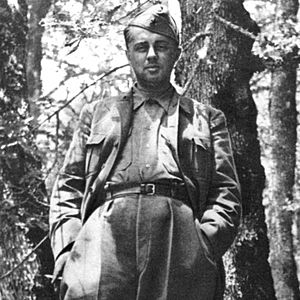
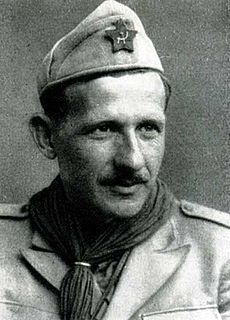
Enver Hoxha and Mehmet Shehu became the most powerful leaders in Albania for many years after the war. Enver Hoxha was born in 1908. He studied in France and Belgium. In 1936, he returned to Albania and taught French. He also joined a Communist group. When the Albanian Communist Party was formed in November 1941, he became its general secretary. He held this position until he died in 1985.
Mehmet Shehu also studied in Albania and then went to a military college in Italy. He was kicked out for his left-wing political views. He fought in the Spanish Civil War and became a commander. He returned to Albania in 1942 and quickly became an important leader. He was known for his strong leadership skills with the partisans.
Starting the Resistance Movements
After Italy invaded Albania in April 1939, 100,000 Italian soldiers and 11,000 Italian settlers moved into the country. At first, the Albanian Fascist Party gained some support. This was mainly because Italy united Kosovo and other Albanian-populated areas with Albania after taking over parts of Yugoslavia and Greece in 1941. Mussolini even boasted that he had created the "Greater Albania" that many Albanian nationalists wanted.
Several groups began to resist the occupation. These included groups led by Baba Faja Martaneshi, Gani bey Kryeziu, Mustafa Gjinishi, and Muharrem Bajraktari. An attempt to unite these groups was made by Major Abaz Kupi. He formed a secret group called the Unity Front. This group grew quickly but was crushed in April 1941 after Yugoslavia and Greece were defeated. Some members joined the Italian side, some were arrested, and others fled to the mountains.
In November 1941, small Albanian Communist groups formed the Albanian Communist Party in Tirana. It had 130 members and was led by Hoxha. At first, the party did not attract many people.
Resistance in Albania grew after Italy's forces were defeated in the war with Greece, which started in October 1940. The promise of a "Greater Albania" had encouraged some Albanians to join the army. But when the Italian attack on Greece failed, many regular soldiers refused to fight. Volunteer units also broke apart, and some soldiers went to the mountains. Soon, dozens of fighting groups and partisan units formed, with over 3,000 men.
In mid-1942, the Communist Party called on young people to fight for Albania's freedom. This brought many new recruits who wanted to be free. In September 1942, the party created a larger group called the National Liberation Movement (NLM). This group included several resistance groups, even some that were against Communism. The NLM's Communist-led fighters, known as the National Liberation Army, ignored warnings from the Italians about revenge attacks. These attacks often made more people want to join the resistance.
In February 1943, the first big meeting of the Albanian Communist Party took place. They decided to create a single national liberation army. They also planned to use larger forces in their attacks. In May, twelve partisan groups attacked the Italian base in Leskovik. Over 1,000 Italians were there. The battle lasted three days, and the partisans captured the town. The Italians lost many soldiers and weapons.
By the summer of 1943, when Italy's power weakened, most of Albania's mountainous areas were controlled by resistance groups. The NLM officially formed the National Liberation Army (NLA) in July 1943. Spiro Moisiu was its military chief, and Enver Hoxha was its political leader. By the end of 1943, the NLA had 20,000 regular soldiers and guerrillas. However, the NLA also fought against other Albanian political groups, not just the Italian occupiers.
Nationalist Resistance: Balli Kombëtar
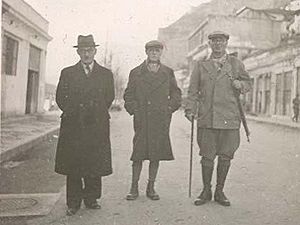
Another resistance group, the Balli Kombëtar (National Front), formed in October 1942. It was led by Ali Këlcyra and Mit’hat Frashëri. This group was against Communism and wanted a republic. They also supported the idea of a "Greater Albania" and wanted economic and social changes. However, their leaders were careful. They feared that the occupiers would punish them or take their land. Many nationalist leaders often worked with the Italians and later the Germans to protect their wealth.
Important Balli Kombëtar commanders included Safet Butka and Hysni Lepenica. Butka was a strong leader in the Korçë area. His group could grow from 70 experienced fighters to a thousand men in an emergency. His forces attacked Italians in different areas in 1943.
Hysni Lepenica led a successful battle in August 1942 with help from Allied planes. After Italy surrendered, Communists and Ballists tried to get Italian forces to surrender peacefully. However, clashes started between the Communists and Ballists. Lepenica died during the battle of Gjorm. In the autumn of 1943, Nazi Germany occupied Albania after Italy was defeated. The Balli Kombëtar then made a deal with the Germans. They formed a "neutral government" in Tirana and continued fighting the NLA and Yugoslav Partisans.
The Balli Kombëtar also fought in Kosovo and Macedonia. Their forces were mainly in Mitrovica, Drenica, and Tetovo. These Ballists were often more aggressive than those in Albania.
From Italian Surrender to German Occupation
When Benito Mussolini's government fell and Italy surrendered in 1943, the Italian military in Albania weakened. Five Italian divisions were disarmed by the Germans. But many Italian soldiers escaped and joined the guerrilla forces. One Italian division, the 41st Infantry Division Firenze, even joined the resistance. The Communists took control of most southern Albanian cities, except Vlorë, which was a Balli Kombëtar stronghold. Nationalists gained control of much of the north.
British agents in Albania told the Albanian resistance that the Allies were planning a big invasion of the Balkans. They urged the different Albanian groups to unite. In August 1943, the Allies convinced Communist and Balli Kombëtar leaders to sign the Mukje Agreement. This agreement was meant to coordinate their fighting. However, the two groups stopped working together because they disagreed about the future of Kosovo. The Communists wanted Kosovo to return to Yugoslavia after the war. The Balli Kombëtar wanted to keep Kosovo as part of Albania.
The Mukje Agreement
The Mukje Agreement was signed on August 2, 1943. It was between the nationalist Balli Kombëtar and the communist National Liberation Movement. They agreed to work together to fight Italy's control over Albania. However, they had a big disagreement about Kosovo. The Balli Kombëtar wanted to fight to make Kosovo part of Albania. The Communist leaders strongly disagreed.
Because of this, the Balli Kombëtar called the partisans "traitors" and "Tito's dogs." The partisans accused the Balli Kombëtar of working with the Axis powers. This started a war between the two Albanian groups that lasted for a year.
German Occupation of Albania
Germany had plans to invade Italian-held areas in the Balkans. In April 1943, German military intelligence sent agents to Mitrovica (in present-day Kosovo). They wanted to gain influence among Albanians who were unhappy with the Italians. In July and August 1943, the German army occupied Albanian airports and ports. They said it was to protect Albania from an Allied invasion. By mid-August, there were about six thousand German troops in Albania.
The Germans wanted to set up an independent, neutral Albania with a government friendly to them. After the Mukje agreement broke down, war started between the Albanian Partisans (supported by Yugoslav Partisans and the Allies) and the Balli Kombëtar. After Italy surrendered on September 8, 1943, German troops quickly occupied Albania with two divisions. The Germans then formed a "neutral government" in Tirana with the Balli Kombëtar.
The Germans tried to get Albanian leaders to form a government to run the country. Many leaders were hesitant, especially with rumors of a British invasion. However, Kosovo Albanian leaders were more willing to cooperate. They knew that if Germany lost, they would return to Yugoslav rule. On September 14, 1943, an Albanian government was formed. It was led by Cafo Beg Ulqini, Ibrahim Biçaku, Bedri Pejani, and Xhafer Deva.
The new government promised to stay neutral in the war. It brought back some stability. The government and justice systems started working again. Albanian schools reopened in northern and central Albania. They also began plans for land reform.
After the neutral government was formed, Ballist forces worked with the Germans. They fought against the Communists. The Balli Kombëtar even captured Struga in Macedonia after defeating the partisan forces there.
In Kosovo and western Macedonia, German and Ballist forces had occasional fights with Yugoslav partisans. Leaders like Fiqri Dine, Xhem Hasa, and Hysni Dema worked with German majors to lead military campaigns against Albanian and Yugoslav partisans.
Tirana was freed by the partisans on November 17, 1944, after a 20-day battle. The partisans completely freed Albania from German occupation on November 29, 1944. The National Liberation Army, which had 70,000 soldiers by October 1944, also helped in the war. Albanian partisans also helped free Kosovo and assisted Tito's Communist forces in freeing parts of Montenegro and southern Bosnia and Herzegovina. At that time, the Soviet Army was also entering Yugoslavia, and the German Army was leaving Greece and moving into Yugoslavia.
Communist Takeover
Provisional Communist Government
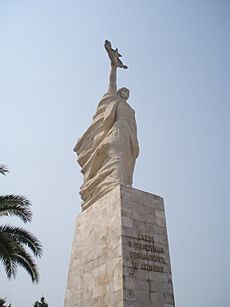
By January 1944, the Communist partisans had regrouped and controlled much of southern Albania. However, German attacks pushed them out of some areas until June. On May 29, the National Liberation Front held a meeting called the Congress of Përmet. They chose an Anti-Fascist Council of National Liberation to act as Albania's government. Hoxha became the head of this council and the supreme commander of the National Liberation Army.
The Communist partisans defeated the last Balli Kombëtar forces in southern Albania by mid-1944. They faced only small resistance when they entered central and northern Albania by the end of July. The British military advised the remaining nationalists not to fight the Communists. The Allies also called back their representatives who were with the nationalists. They did not help nationalist leaders escape, though many fled on their own.
Before the end of November, the main German troops left Tirana. The Communists then took control of the city. A temporary government, formed by the Communists in Berat in October, began to govern Albania. Enver Hoxha became the prime minister.
What Happened After the War?
Albania faced many challenges after World War II. The National Liberation Front had strong ties with Yugoslavia's Communists. This meant Yugoslavia would play a big role in Albania's future. The Allies never recognized any Albanian government in exile or King Zog. They also did not discuss Albania's borders at major wartime meetings.
There are no exact numbers for Albania's wartime losses. But reports suggest about 30,000 Albanians died in the war. Also, 200 villages and 18,000 houses were destroyed. About 100,000 people were left homeless.
During the Nazi occupation, most Jewish people in Albania were saved. However, in Kosovo, Albanian groups working with the Axis forces harmed Serb and Montenegrin settlers. Many were forced out or sent to camps. Thousands were killed.
Foreigners in the Resistance
Many foreign citizens helped the Albanian resistance during World War II. Most were Italian soldiers who wanted to keep fighting against Nazi Germany. But people from other countries also joined.
Italian Soldiers Helping the Resistance
Albanian resistance started in 1940 with small groups. It became much stronger by 1942. Even then, small groups of Italian soldiers left the Fascist army and joined the Albanian partisans. When Italy surrendered in September 1943, about 122 Italian partisans were already fighting with the Albanian National Liberation Army.
When Italy surrendered, about 100,000 Italian soldiers were in Albania. Many surrendered to the German army. Most were sent to concentration camps or forced to work for the Germans. There were also mass killings of Italian officers.
Some Italians hid in the mountains. About 15,000 Italian soldiers surrendered to Albanian partisans. Some Italian troops formed a group called CITM (Italian Command of the Troops in the Mountains). They wanted to fight German troops with the help of Albanian Partisans. They formed some Italian units, but these were broken up by a German attack in late 1943.
About 2,150 Italians wanted to keep fighting with the Albanian partisans. Some 472 Italian fighters joined partisan brigades. For example, a group of 137 men formed the Antonio Gramsci Battalion. Other Italian units also fought with Albanian partisans.
German Deserters
Some German forces in Albania were made up of recruits from the Caucasus region. The first German soldiers who left their units joined Albanian Partisan groups in late 1943. Their numbers grew in the summer of 1944. Many more German soldiers deserted at the end of the war, from September to October 1944, as German forces left Albania. In August 1944, a new unit was formed from about 40 German deserters (mostly Armenians and Turkmen). Another 70 Armenians formed their own unit. There were also small groups of German deserters from other countries, like France, Czech Republic, and Poland, who joined the Albanian partisans.
Allied Support
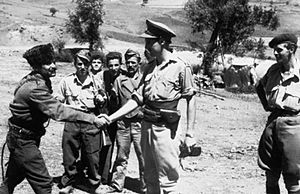
The British tried to work with Albanian resistance groups in early 1941. But these efforts stopped when Germany and Italy took over Yugoslavia. No new attempts were made until April 17, 1943. That's when the SOE, a British organization, sent a mission to Albania. It was led by Lieutenant Colonel "Billy" MacLean and Major David Smiley. They entered Albania from Greece.
The mission connected with the NLM. The first delivery of weapons and equipment arrived on June 27. Most of these supplies went to the NLM, which was the strongest group in Southern Albania. They used them to equip their "First Partisan Brigade."
Later in 1943, the SOE sent more people to Albania. The new commander was Brigadier Edmund Frank Davies. MacLean and Smiley reported that the Communist-led NLM seemed more interested in gaining political power after the war than fighting the Germans. But they still recommended that SOE continue to supply them.
In January 1944, the Germans attacked the British mission's headquarters. Brigadier Davies was captured. Lieutenant Colonel Nicholls died after leading the survivors to safety.
Throughout 1944, SOE continued to supply the NLM. This happened even though MacLean and Smiley reported that the NLM was using these weapons against other Albanian political groups, not just the Germans. Smiley, MacLean, and Julian Amery were evacuated to Italy in October. The SOE refused to evacuate Abaz Kupi. He escaped on his own and was picked up by a British naval ship.
See also
- Albania under Italy
- Besa tradition during World War II
- The Holocaust in Albania
- Participants in World War II
- Timeline of Albanian history
- Socialist People's Republic of Albania
- Antonio Gramsci Battalion
- Greco-Italian War


